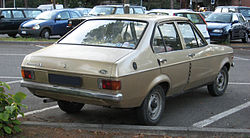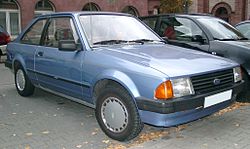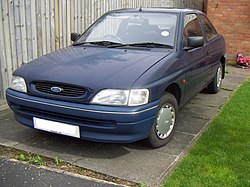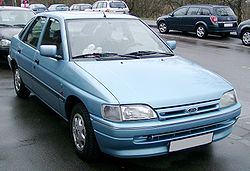Ford Escort

 |
|---|
|
The Ford Escort is a small family car manufactured by the Ford Motor Company's European division between 1968 and 2000. The Escort name was also applied to several different designs in North America over the years . The first use of the Escort name was for a reduced specification version of the Ford Squire, a 1950s estate car version of the Ford Anglia 100E, though this did not sell very well by comparison to the other members of the 100E family. |
 |
 |
|---|---|
 |
 |
 |
 |
 |
 |
|---|---|
 |
 |
 |
 |
|
|
||||||||||||||||||||||||||||||||||||||||
|---|---|---|---|---|---|---|---|---|---|---|---|---|---|---|---|---|---|---|---|---|---|---|---|---|---|---|---|---|---|---|---|---|---|---|---|---|---|---|---|---|---|
 |
 |
||||||||||||||||||||||||||||||||||||||||
 |
 |
||||||||||||||||||||||||||||||||||||||||
 |
 |
|---|---|
 |
 |
 |
 |
 |
|---|
| The Mark I Ford Escort was introduced in the United Kingdom at the end of 1967, making its show debut at Brussels Motor Show in January 1968.It replaced the successful long running Anglia. The car was presented in continental Europe as a product of Ford's European operation. Escort production commenced at Halewood in England during the closing months of 1967, and for left hand drive markets during the autumn fall of 1968 at the Ford plant in Genk. Initially the continental Escorts differed slightly from the UK built ones under the skin. The front suspension and steering gear were differently configured and the brakes were fitted with dual hydraulic circuits; also the wheels fitted on the Genk-built Escorts had wider rims.At the beginning of 1970, continental European production transferred to a new plant on the edge of Saarlouis, West Germany. |
 |
|---|
The Escort was a commercial success in many parts of western Europe, but nowhere more than in the UK, where the national best seller of the 1960s, BMC's Austin/Morris 1100 was beginning to show its age while Ford's own Cortina had grown, both in dimension and in price, beyond the market niche at which it had originally been pitched.  In June 1974, six years into the car's UK introduction, Ford announced the completion of the two millionth Ford Escort, a milestone hitherto unmatched by any Ford model outside the USA.It was also stated that 60% of the two million Escorts had been built in Britain |
|
|
|||||||||||||||||||||||||||||||||||||
|---|---|---|---|---|---|---|---|---|---|---|---|---|---|---|---|---|---|---|---|---|---|---|---|---|---|---|---|---|---|---|---|---|---|---|---|---|---|---|
 |
 |
|||||||||||||||||||||||||||||||||||||
 |
 |
|---|---|
 |
 |
 |
|---|
The Escort had conventional rear-wheel drive and a four-speed manual gearbox, or 3-speed automatic transmission. The suspension consisted of MacPherson strut front suspension and a simple live axle mounted on leaf springs. The Escort was the first small Ford to use rack-and-pinion steering, its predecessor had used the, at the time, more traditional steering box set up.  The Mark I featured contemporary styling cues in tune with its time: a subtle Detroit-inspired "Coke bottle" waistline and the "dogbone" shaped front grille arguably the car's most famous stylistic feature. Similar "Coke Bottle" styling featured in the larger Cortina Mark III (also built in West Germany as the Taunus) that was launched in 1970. |
 |
|---|
| There was a 1300GT performance version, with a tuned 1.3 L Kent (OHV) engine sporting a Weber carburetor and uprated suspension. This version also featured additional instrumentation with a tachometer, battery charge indicator and oil pressure gauge. The same tuned 1.3 L engine was also used in a variation sold as the Escort Sport, that used the flared front wings from the AVO range of cars, but featured trim from the more basic models. Later on a further "executive" version of the Escort was produced known as the 1300E. This featured the same 13" road wheels and flared wings of the Sport, but was trimmed in an upmarket, for that time, fashion with wood trim on the dashboard and door cappings. |
|
 |
||||||||||||||||||||||||||||||||||
|---|---|---|---|---|---|---|---|---|---|---|---|---|---|---|---|---|---|---|---|---|---|---|---|---|---|---|---|---|---|---|---|---|---|---|---|
 |
|---|
| There was, in the early days of the Escort, a higher performance version for rallies and racing — the Escort Twin Cam,( built for Group 2 international rallying) which featured an engine with a Lotus-made eight-valve twin camshaft head fitted to the 1.5 L non-crossflow block, which had a bigger bore than usual to give a capacity of 1,558 cc. This engine had originally been developed for the Lotus Cortina. Production of the Twin Cam, which was originally produced at Halewood, was phased out as the RS1600 was developed. The Mark I Escorts became very successful as a rally car, and they eventually went on to become one of the most successful rally cars of all time.The Ford works team was practically unbeatable in the late 1960s / early 1970s, and arguably the Escort's greatest victory was in the 1970 London to Mexico World Cup Rally being driven by Finnish legend Hannu Mikkola. This gave rise to the famous Escort Mexico (1.6 L "Kent"-engined) special edition road versions in honour of the rally car. |
 |
|---|
|
Ford also produced an RS2000 model as a more "civilised" alternative to the somewhat temperamental RS1600, featuring a 2.0 L Pinto (OHC) engine. This also clocked up some rally and racing victories; and pre-empted the hot hatch market as a desirable but affordable performance road car. Like the Mexico and RS1600, this car was produced at the Aveley plant. The Escort quickly became one of Britain's most popular cars, comfortably outselling the conceptually similar Vauxhall Viva HB launched two years earlier. It was also a success on export markets, though in the larger European markets it tended to be outsold by the Opel Kadett, its General Motors rival. The car was built in Germany, Britain and in Commonwealth countries such as Australia and New Zealand. Ford New Zealand's Seaview plant in Lower Hutt built 1.1 and 1.3-litre versions, initially as Deluxe (1.1) and Super (1.3) two-door sedans plus panel vans. The four-door sedan was added in 1970. Trim levels were revised after the 1972 UK facelift with just one run of 1.3XLs (with the GT instrument pack) before these were downgraded to 'L' trim. Base and L trims were offered to the end of the MK1 run. Some 1.6 Mexicos were imported in 1973-4 after the government temporarily freed up import licensing due to a shortage of new cars. Estate versions were mostly rare imports. |
|
|
||||||||||||||||||||||||||||||||
|---|---|---|---|---|---|---|---|---|---|---|---|---|---|---|---|---|---|---|---|---|---|---|---|---|---|---|---|---|---|---|---|---|---|
 |
 |
||||||||||||||||||||||||||||||||
 |
 |
||||||||||||||||||||||||||||||||
 |
|---|
| The squarer-styled Mark II version appeared in January 1975. The first production models had rolled off the production lines on 2 December 1974.
Unlike the first Escort (which was developed by Ford of Britain), the second generation was developed jointly between the UK and Ford of Germany. Codenamed "Brenda" during its development, it used the same mechanical componentss as the Mark I. This car made a point, with just four body styles, of competing in many different market niches where rival manufacturers had either multiple model ranges or simply none at all. "L" and "GL" models (2-door, 4-door, estate) were in the mainstream private sector, the "Sport", "RSMexico", and "RS2000" in the performance market, the "Ghia" (2-door, 4-door) for an untapped small car luxury market, and "base / Popular" models for the bottom end. Panel-van versions catered to the commercial sector. During the second half of the 1970s, the Escort continued to prove hugely popular with buyers in Britain and other parts of Europe.A cosmetic update was given in 1978, with L models gaining the square headlights previously exclusive to the GL and Ghia variants and there was an upgrade in interior and exterior specification for some models. Underneath a wider front track was given. In 1979 and 1980 three special edition Escorts were launched the Linnet, Harrier and Goldcrest. Production, after an incredibly popular model run, ended in Britain in August 1980, other countries following soon after. |
 http://www.edmunds.com/ford/escort/ http://www.edmunds.com/ford/escort/ |
 |
|---|---|
 http://www.ananzi.co.za/ http://www.ananzi.co.za/motoring/ford-escort-mk1.html |
 |
 http://www.pistonheads. http://www.pistonheads.com/sales/3131376.htm |
 |

 Ford Escort (Europe)
Ford Escort (Europe)




















 HOME;
HOME;






